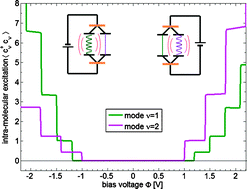Bias-controlled selective excitation of vibrational modes in molecular junctions: a route towards mode-selective chemistry
Abstract
We show that individual vibrational modes in single-molecule junctions with asymmetric molecule–lead coupling can be selectively excited by applying an external bias voltage. Thereby, a non-statistical distribution of vibrational energy can be generated, that is, a mode with a higher frequency can be stronger excited than a mode with a lower frequency. This is of particular interest in the context of mode-selective chemistry, where one aims to break specific (not necessarily the weakest) chemical bond in a molecule. Such mode-selective vibrational excitation is demonstrated for two generic model systems representing asymmetric molecular junctions and/or scanning tunneling

- This article is part of the themed collection: Molecular electronics

 Please wait while we load your content...
Please wait while we load your content...